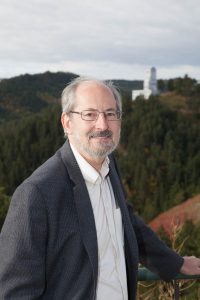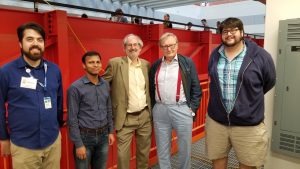 |
Professor B.Sc., University of London (1977) Ph.D., Purdue University (1983) |
Experimental High-Energy Physics
For much of my early career I worked on experiments at the Stanford Linear Accelerator Center (SLAC) using high energy electron-positron colliders in my quest to understand the fundamental forces of nature. My PhD thesis and post-doc experiments that were among the early searches for supersymmetric particles (the High Resolution Spectrometer and Anomalous Single Photon collaborations). This was followed by the SLD experiment at the only linear electron-positron collider to study the properties of the Z0 weak boson with a focus on the decays to strange particles tagged with the intricate Cherenkov Ring-Imaging Detector (CRID) subsystem. Working on the Beijing Spectrometer (BES) experiment at the Beijng Electron Position Collider in China I met my future CSU colleague Walter Toki. In the BaBar collaboration at SLAC, I helped to design and build the novel Detector of Internally Reflected Cherenkov light (DIRC) that was part of an important measurement of Charged-Parity (CP) violation in B meson decays. CP violation may explain the matter-antimatter asymmetry of the universe and has been a central theme of my research for nearly 20 years. Along the way and I contributed to studies of particle identification in detectors at a future International Linear Collider, which is under consideration for construction in Japan.
After establishing that CP violation in the quark sector could not explain the baryon asymmetry, I shifted gears to focus on experiments involving neutrinos – the most abundant known matter particle in the universe. First as a member of the Tokai-to-Kamoika (T2K) long-baseline neutrino oscillation experiment that produces an intense neutrino beam in a facility on the east coast of Japan and studies the beam with a 50-kton water Cherenkov detector, 1000 m underground and 295 km away. I helped to build the T2K Pi-Zero Detector, which is part of the ND280 complex near the beam source, and with my students and post docs I studied the production of pions when neutrinos interact with water and carbon. The T2K collaboration was co-recipient of the Breakthrough Prize in Fundamental Physics for discovery of oscillations of muon neutrinos into electron neutrinos.
In the early 2000’s, I was the co-PI for a proposed new national underground science laboratory in the US. This led to my current involvement in the Deep Underground Neutrino Experiment (DUNE) at the Long-Baseline Neutrino Facility (LBNF). LBNF will send an even more powerful neutrino beam (eventually more than 2 MW) from Fermi National Accelerator Laboratory (Fermilab) near Chicago, over 800 miles through the Earth’s crust to a 70-kton detector consisting of four gigantic liquid argon time-projection chambers (LArTPC) constructed a mile underground at the Sanford Underground Research Facility (SURF) in Lead, South Dakota. I am chair of the 180-member DUNE Institutional Board and a member of the board of directors for SURF. At CSU I have helped to develop photon detectors (PD) for the DUNE far detector and I am an editor for the Technical Design Report. Recently, our group demonstrated that photon detectors could be used to measure the energy of supernova neutrinos as well as, or better than, the TPC.
Finally, I am one of the leaders of the ICARUS collaboration at the Short-Baseline Neutrino (SBN) program at Fermilab whose primary goal is to perform a definite search for sterile neutrinos – these particles do not interact directly with matter but come in existence only through a quantum mechanical oscillation outside of the Standard Model of particle physics, which features three neutrino flavors that interact through weak boson exchange. The far detector is a 750-t LArTPC built by the original Italian ICARUS group led by Nobel Laureate Carlo Rubbia who invented this approach. Our group at CSU has developed the photosensor readout for the Cosmic Ray Tagger, is developing the data acquisition system and is studying backgrounds essential for the oscillation analysis.

